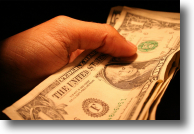 |
I have always been under the impression that a dividend payout ratio must not be too high because it can limit the ability of the company to grow. In fact, in my weekly dividend stock analysis posts [1], I look for a dividend payout ratios that are at least below 60%, preferably even lower. I have selected this target because I have believed that the lower payout ratio will provide the company with a sizable chunk of earnings to grow the business and with a lower than 60% dividend payout ratio a company can continue to grow its dividend even during time of economic slowdowns or reduced earnings. It appears that this theory and fundamental analysis principle has been refuted in a study by Robert D. Arnott and Clifford S. Asness [2] (pdf document). Their theory is that higher dividend payouts actually have lead to higher earnings growth. And with higher earnings growth, share prices tend to go up over time which is better for all of us investors. Let’s have a look at their research and findings.
…But First a Definition of the Payout Ratio
The payout ratio is the percentage of a company’s earnings that are paid out as dividends. In a nutshell, the payout ratio provides an idea of how well earnings support the dividend payments. More mature companies tend to have a higher payout ratio.
Support for Higher Dividend Payout Ratios and Earnings Growth
The crux of the Arnott and Asness research really boils down to one chart in the 87 page report. Being the good guy that I am 🙂 I will summarize the report by presenting this chart to you. Have a look and it is clear that there is a trend happening here.
 [3]Click to Enlarge
[3]Click to EnlargeAs you can see, for a high number of companies, the higher the payout ratio is the better earnings growth the companies experienced. Here are some comments from the authors:
In general, when starting from very low payout ratios, the equity market has delivered dismal real earnings growth over the next decade; growth has actually fallen 0.4 percent a year on average–ranging from a worst case of truly terrible –3.4 percent compounded annual real earnings for the next 10 years to a best case of only 3.2 percent real growth a year over the next decade. From a starting point of very high payout ratios, the opposite has occurred: strong average real growth (4.2 percent), a worst case of positive 0.6 percent, and a maximum that is a spectacular 11.0 percent real growth a year for 10 years.
So what do we, the average investors (no offense to anyone) do with this data? My view is that I am going to continue to use my 60% payout ratio benchmark, but will not scoff at a higher dividend payout ratio as quickly. I still believe that it is the average historical payout ratio that an investor must be concerned with – any recent jumps in the payout ratio need to be examined to determine why the change occurred. Let me know what you think we should do – I am looking for your comments using the comment section below.
(Photo Credit: Sufi Nawaz [4])
Google+ [5]